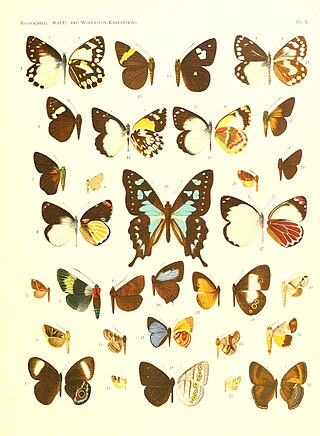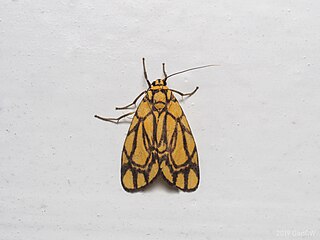
The Arctiini are a tribe of tiger moths in the family Erebidae.

Graphium stresemanni is a vulnerable species of butterfly in the family Papilionidae. It is endemic to the Indonesian island of Seram. It closely resembles the related Graphium weiskei, a more common species from New Guinea but has been treated as a distinct species. It is rare. The species was first described by Walter Rothschild in 1916.
Cyme is a genus of moths in the family Erebidae. The genus was described by Felder in 1861.
Dolgoma is a genus of moths in the family Erebidae. The genus was erected by Frederic Moore in 1878.

Lyclene is a genus of lichen moths of the family Erebidae, subfamily Arctiinae. The genus was erected by Frederic Moore in 1860.

Argina astrea, the crotalaria podborer, is a moth of the family Erebidae. The species was first described by Dru Drury in 1773. It is found in eastern Africa, southern Asia of India, Sri Lanka, Maldives and Indo-Australia, including the Pacific Islands and Australia.

Lyclene structa is a species of moth of the subfamily Arctiinae first described by Francis Walker in 1854. It is found in the southern half of Australia.

Cyme euprepioides is a species of moth of the family Erebidae. It is found on Borneo, Sumatra, Peninsular Malaysia and in the north-eastern Himalayas and the Philippines. The habitat consists of various lowland forest types.

Cyme phryctopa is a moth of the family Erebidae. It is found in New Guinea.

Cyme pyraula is a moth of the family Erebidae first described by Edward Meyrick in 1886. It is found in the Australian state of Queensland and on New Guinea.

Cyme sexualis is a moth of the subfamily Arctiinae first described by Felder in 1864. It is found on Ambon, Sulawesi, the Dampier Archipelago, and in New Guinea.

Asura synestramena is a species of lichen moths of the family Erebidae, subfamily Arctiinae. It is found on Borneo and Bali. The habitat consists of lowland forests.
Cyme anaemica is a moth of the family Erebidae first described by George Hampson in 1911. It is found in Papua New Guinea.

Cyme coccineotermen is a moth of the family Erebidae first described by Walter Rothschild in 1913. It is found in Papua New Guinea.
Cyme basitesselata is a moth of the subfamily Arctiinae.
Eugoa dissozona is a moth of the family Erebidae first described by Edward Meyrick in 1889. It is found on New Guinea, where it is a common and widely distributed species. Specimens resemble those of Eugoa regalis. In his original description of the species, Meyrick gave a wingspan of 24 mm.
Cyme effasciata is a species of moth in the family Erebidae. It is found on Ambon Island in Indonesia. It was described by Felder in 1861.
Lyclene apiseriata is a species of lichen moths of the family Erebidae, subfamily Arctiinae. It was described by Jeremy Daniel Holloway in 2001. It is found on Borneo. The habitat consists of lower montane forests on limestone.
Lyclene weidenhofferi is a moth of the subfamily Arctiinae. It was described by Karel Černý in 2012 and is endemic to Thailand.

Cyme laeta is a moth of the subfamily Arctiinae first described in 2021 by the then 18-year-old Noortje Looijenga during her internship at the Naturalis Biodiversity Center in the Netherlands. It is found in New Guinea. Laeta is Latin for happy, surprise, colorful and rich in contrast. Looijenga explained that: "Of course, this refers to my joy upon discovering this new species. Moreover, Cyme laeta is slightly more strongly colored than their sister species Cyme reticulata." The type specimen had been caught by Rob de Vos, her internship supervisor, during a work trip. The determination that this was a different species was made by Looijenga by examining the sex organs under a microscope.












